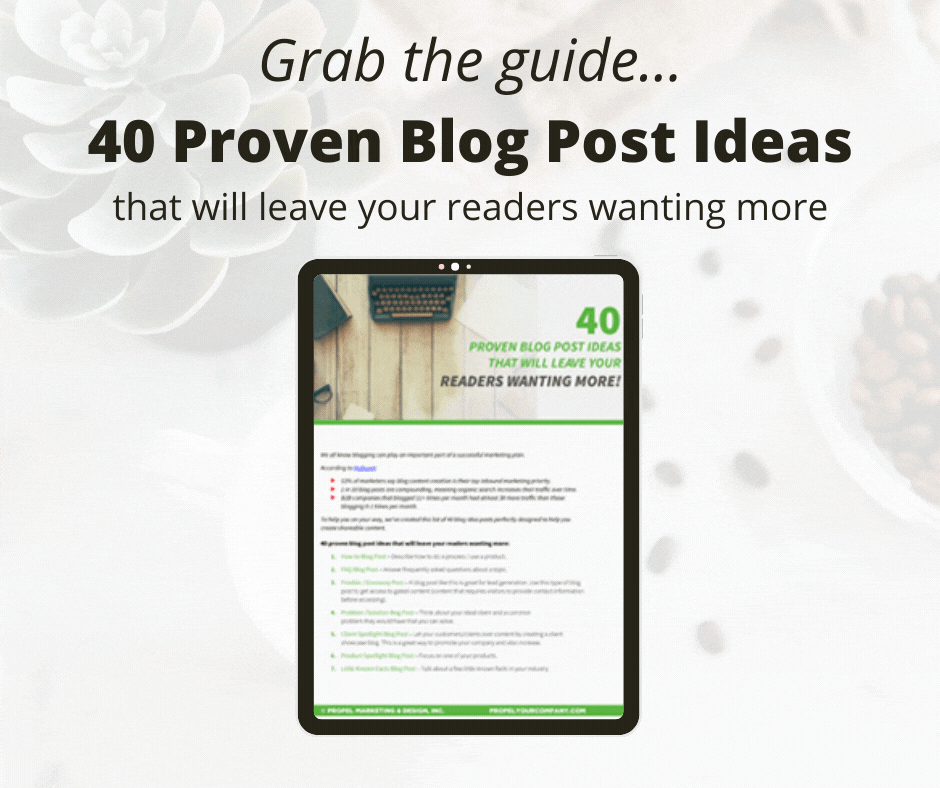Welcome to part two of our blogging series! Today, we’re giving you some pro tips that will help you write better blog posts because, let’s face it, we’re not all bloggers.
When you started in your field, you likely didn’t think that creating content would be part of your marketing plan. However, in this web-driven world, good website content is a necessity.
Don’t worry, though; we’ve got you. We know all about writing successful blog posts, and we’re confident our 12 blog writing tips will pay off for you!
Here’s what you can expect to take away from this episode:
Our pro tips that will help you create excellent blog posts
What you can expect from Google Analytics
How to implement your keywords when you write a blog post
Our number one, most favorite blog writing tip
Our go-to tool for grammar and spelling
The best part of writing great content: repurposing it and updating it!
And more
Are you ready to learn our 12 pro tips for creating better blog posts that lead to more visitors online and in your clinic? Hit the link, and let’s do it!
Listen to the audio version:
Watch the video version:
Show Notes
[00:01:55] How does Google Analytics tell me how my blog posts are doing? Google Analytics is an awesome free tool that gives you loads of insight regarding your website's performance (including your blog!).
[00:02:30] Will knowing my buyer persona help me write better blog posts? Absolutely. You have to know your audience to know how to attract them and connect with them.
[00:03:15] How do I use my keywords in my blog post? What comes first, the blog post or the keywords? It’s an age-old question, and we have the answer.
[00:04:16] What is intentional content? Content that directly serves your buyer persona, it’s specific and resourceful, written with intent so it can be leveraged in many places.
[00:09:10] Do I need to consider SEO in my blog posts? Oh, yes. SEO is should be part of all of your content on every page of your website.
[00:12:04] What are other ways I can increase my online presence? Check out our free masterclass Five SEO Secrets to Owning the First Page of Google Without Buying Ads.
[00:13:04] Want to suggest a topic or guest? Please do so! I’m up for a challenge! Suggest a topic for an upcoming episode of the Propel Your Practice Podcast
Selected links and other resources related to this episode:
On this episode at Propel Your Practice, I'm sharing with you my favorite tips for creating better blog posts.
Well, hello and welcome to the Propel Your Practice Podcast where we discuss actionable marketing strategies to help clinic owners propel their practices’ presence online.
I'm your host Darcy Sullivan with Propel Marketing & Design.
We are in a series dedicated to discussing blog posts. In this episode, I'll be sharing with you 12 of my favorite tips for creating better blog posts.
The episodes that follow this one will also include topics around creating better blog posts and in a couple of the upcoming episodes, we'll be discussing the anatomy of an effective blog post where I'll be sharing with you some of my favorite blogging tools and much more.
Before we get started today, I would love to invite you to join my free training, called the Five SEO Secrets to Owning the First Page of Google Without Buying Ads. You can sign up for that free workshop by visiting propelyourcompany.com/learn or grab the link in the Show Notes.
Alright on with today's show.
So in today's show, I'm going to be sharing with you 12 of my favorite tips for creating better blog posts. And to be honest, number four is my favorite. But we'll get there. So let's start with number one.
Number one set up Google Analytics so you can track your performance. If you haven't had the opportunity to install Analytics on your website, which includes your blog, now is the time to do so. This will give you tons of insight into the actions people are taking when they visit your website and help you to determine the performance of each of your blog posts.
Tip number two. Right, like, you're talking to one person. I know it can be difficult to sit down and write a blog post sometimes, but if you identify the buyer persona that you're trying to connect with on each specific blog post, then visualize one person that fits that buyer persona, your words are going to flow smoother and you're going to be able to address their pain points better.
If you aren't familiar with buyer personas or have never taken the time to walk through the exercise of clearly identifying your buyer personas, we had a podcast that we did recently covering that exact process. And we have additional resources on our blog, so we'll be sure to include those in the Show Notes for this episode.
Tip number three, make sure you identify the keyword or keyword phrase you're trying to target in each specific blog post before you write it.
One issue that I've seen many times is that people will write a blog post and then they'll say, “Okay, well, what keywords should I associate with this blog post?” You want to identify your targeted keyword or keyword phrase before you start writing the blog post to ensure that you're using it properly throughout that blog post.
You don't want to wait until after you've written the blog post to identify which keyword phrase you want to target for that post.
On the episode where we walk through the anatomy of an effective blog post. You'll see examples of where and how you should use your keyword throughout a blog post.
Tip number four, and again, this is one of my favorites, this is actually one of the biggest takeaways that I hope you have when it comes to creating blog posts: Try to create some blog posts that contain intentional content.
When I say intentional content, I'm referring to content that you intentionally identified, that will have multiple purposes.
So let's look at an example of this. Let's say you're a chiropractor, sure you could write a blog post on back pain and it could be a very generic blog post about back pain.
But what would serve you better from many standpoints? If you identified your target audience and their needs and then put together an intentional piece of content around it, that you know, you have resources that will help you spread that information.
So, what are some examples of this?
Let's use the example of a chiropractor. Let's say you're a chiropractor and you have a relationship with local organizations, maybe a few gyms or a running club. What if you put together a blog post that met the needs of that specific target audience? Maybe for the running club, it's three stretches to help runners prevent injuries. That would be a phenomenal resource directly for them.
Then what if you gave it to the head of that organization to share with their audience, you're going to get more leverage from that blog post; one, because you're leveraging the audience and getting other people to share it for you. Two, it's positioning you as the go-to person in that specific niche.
Or another example–we'll stay along the lines of a chiropractor–if you focus on prenatal chiropractic care. If you put together a piece of content that, you know, a mommy blogger, for example, or a doula would want to share with their audience, you're going to be more likely to get that piece of content- that blog post to go viral.
So again, one of the big takeaways here is to try to create intentional content when you're blogging. Content that serves multiple purposes and will be more likely to be shared by other people to drive more traffic to your website.
Tip number five: outline before you write. Outlining your blog posts before you write them, will help you organize your thoughts before you start typing away at your keyboard.
It gives you a chance to cut out some of the things that don't really fit, to organize the natural progression of topics. And it'll make it easier because you'll already have an idea of sub-headers and different sections that you should include in your blog post. This will also make your blog post more digestible and easier to read.
Tip number six, read your copy out loud. This helps you not only pinpoint areas where things don't really flow that well, but it also gives you the opportunity to confirm that you're properly using your keyword phrase throughout and that you truly are getting across the points that you have outlined that you want to make sure are covered in that specific blog post. Then take it one step further and have somebody else proofread your piece of content.
And while we have a whole episode that I'm dedicating to logging tools, one that I'm going to go ahead and mention in here is Grammarly. If you aren't using Grammarly, be sure to check out the Show Notes and grab the link to this amazing free tool that will help you with your spelling and your grammar as you're putting together a new blog post.
Tip number seven, oh, this is a doozy, pay attention to image copyrights and licensing. You want to make sure that you're not just grabbing images from the internet that you don't have the rights to use.
Tip number eight: make sure that you implement proper SEO. This could be a whole episode in itself.
I just want to mention a couple of SEO elements that you want to be sure that you're implementing as you're putting together blog posts that include:
Providing a meta title and page description
Using image alt text
Properly using links and header tags
And again, we'll talk about some of those elements on the episode where we discuss the anatomy of an effective book post. But if SEO is all new to you, make sure that you check out that free webinar that I mentioned at the beginning of this episode, it'll get you started in the right direction on improving your overall SEO strategy.
Tip number nine: repurpose your content. You don't always have to come up with a new blog post idea.
For example, if you have videos that you've been creating that are sitting on YouTube, why not turn one or more of those into a blog post? Just make sure that you do more than open up a post on your website and just drop the video in. You need content surrounding it.
So you could do an introduction and then embed the video and then talk more about what is covered in the video after the area where you've embedded it.
Tip number 10: consistency is key. Put together a content calendar. This will help you streamline your workflow.
Tip number 11, continue to post and share your blog post. Just because you shared one of your blog posts on social media two months ago doesn't mean you can't share it again.
You can also leverage your blog posts by turning them into an email campaign that will then link to the original blog post and drive traffic to your website.
Tip number 12, revisit blog posts every six months or so to see what can or should be modified or updated.
In the Show Notes for this episode, you'll find a link to a blog post we wrote on the 7 ways to update old blog posts to boost SEO.
Listen, I get it, blogging can be hard, especially when you're just getting started and you need to publish consistently and promote your articles. But the good news is you aren't alone.
I'm thrilled that you're joining us during this little series that we put together on how to create better blog posts.
If you enjoyed this episode, please leave us a review or share it with somebody you think would also enjoy it. And look out for the next coming episodes where we dive even deeper into creating better blog posts.
Before we head out, I want to invite you to join in on a free masterclass I put together on the Five SEO Secrets to Owning the First Page of Google Without Buying Ads.
You can find a link to sign up for this free masterclass in the Show Notes of this episode or by visiting PropelYourCompany.com/learn.
During this workshop, we do a deep dive into strategies to help you improve your online presence. Including your Google Business Profile, that's what used to be called the Google My Business listing, and what controls the Google Maps section. Along with how voice SEO plays a big role in today's search and where you should be focusing your efforts online for the biggest impact.
All right. Well, that's it for today. Again, you can join the masterclass by visiting PropelYourCompany.com/learn. And if you have a topic that you would like to hear on an upcoming episode of Propel Your Practice, please send it in by visiting PropelYourCompany.com/podcast-topics or looking for the link in the Show Notes.
Thanks so much for your time. I'll talk to you soon.
Darcy’s SEO strategies are easy to implement and effective. She’s the #1 SEO expert I refer to whenever I need help with my rankings.
- Nicholas Scalice, Growth Marketing Podcast // Growth Marketer
Get our next podcast episode delivered directly to your inbox:
We'll email you when we release new episodes.
Sponsors
This episode of the Propel Your Practice Podcast is brought to you by Propel Marketing & Design. Propel Marketing & Design helps Chiropractors, Acupuncturists, Physical Therapists, Wellness Practitioners, and other clinic owners improve their website rankings.
Do you have a suggestion for an upcoming topic or guest?
We love a good suggestion and we’re happy to take yours! Tell us about a topic you want to hear more about or a guest you think would make an impact here and we’ll take care of the rest.
Interested in sponsoring a Propel Your Practice Podcast episode?
If your organization would be a good fit for our target audience, we’d love to work with you. Hit the link below and let’s talk.










![How to Write a Professional Chiropractic Bio [Template Included]](https://propelyourcompany.com/wp-content/uploads/write-a-bio-500x383.jpg)

